Game-Specific Content Structures
When creating a new realm, you’re given the option to choose from a list of pre-defined game system structures that are tailored for a few of the most popular RPGs. The initial list of choices is small, but we expect it to grow in time. Depending on which RPG(s) you play, the question arises whether to adopt a pre-defined structure for your realm. This diary entry delves into the Realm Works content structure and how that structure is tailored for specific game systems.
Generic Global Structure
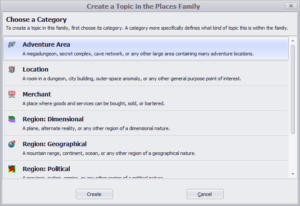 Before we dive into game-specific aspects, let’s start with a brief look at the generic content structure that provides the foundation for everything in Realm Works. When you add material to your realm, it primarily takes the form of topics (story) and articles (mechanics), and the structure of each topic/article is determined by a named content type you choose (e.g. Individual, Location, Creature, etc.). Each named content type reflects a Category definition that specifies the various sections and snippets to appear within any topic/article derived from it.
Before we dive into game-specific aspects, let’s start with a brief look at the generic content structure that provides the foundation for everything in Realm Works. When you add material to your realm, it primarily takes the form of topics (story) and articles (mechanics), and the structure of each topic/article is determined by a named content type you choose (e.g. Individual, Location, Creature, etc.). Each named content type reflects a Category definition that specifies the various sections and snippets to appear within any topic/article derived from it.
You can review the defined structure of every category within your realm by clicking on the Manage menu at the top and then the “Categories” button on the ribbon bar that appears. The name of each category appears in the navigation pane on the left, and clicking on a category populates the content pane with the corresponding structure. You are free to fully customize category definitions to suit your purposes, adding to the pre-defined structure, removing/hiding aspects you dislike, and even wholesale replacing what Realm Works provides out of the box. You can also do the same for all the tag domains and tags which are referenced by the category definitions (via the “Tags” button on the “Manage” ribbon). However, customization is a subject for a future diary entry, so we won’t go any further down that path. Our focus here is on viewing the default structures and seeing how they evolve for specific game systems further below.
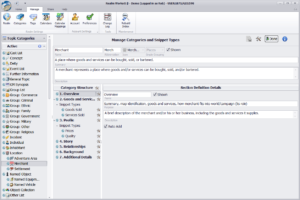 Gamers play a myriad RPGs, and Realm Works is designed to work well for all of them. As such, Realm Works starts out with a pre-defined content structure that is generic and can be readily utilized for virtually any game system, regardless of genre or game mechanics. Everything in the generic structure is necessarily a bit more abstract and qualitatively focused than most game systems, giving each GM a cleanly organized framework for capturing the particulars of his campaign, but without imposing anything too specific.
Gamers play a myriad RPGs, and Realm Works is designed to work well for all of them. As such, Realm Works starts out with a pre-defined content structure that is generic and can be readily utilized for virtually any game system, regardless of genre or game mechanics. Everything in the generic structure is necessarily a bit more abstract and qualitatively focused than most game systems, giving each GM a cleanly organized framework for capturing the particulars of his campaign, but without imposing anything too specific.
Enter the Game Specific Structure
This abstract design works extremely well for GMs creating all their own material. However, it’s not ideal for GMs wanting to pull lots of published material into their campaign, since the published material typically has a more formalized and rigidly followed structure that doesn’t translate seamlessly into the purposely generic one. For story content, the differences are typically localized and readily handled, but the differences can become significant on the mechanics side. GMs are left to choose to adapt the pre-defined structure to suit their preferences or establish their own conventions for mapping the published material into place. While this works, the ideal scenario is having a fully tailored, pre-defined structure already in place for a given game system – allowing the GM to simply pick from a list and be off to the races.
So how does this work? Each game-specific structure starts with the generic structure and is adapted from there. Depending on the RPG, a game-specific structure may be tied to a particular edition of a game system. Games like Dungeons & Dragons® and Star Wars® have multiple editions that are drastically different from one another, so any Realm Works structure must be tailored to match a given edition. Other RPGs like Savage Worlds and Call of Cthulhu also have multiple editions, but the differences between those editions are relatively minor, so a single structure works well across all editions of the game.
Designing an effective game-specific structure involves three core aspects, with each having very different considerations and implications. We’ll explore these in the following sections.
Game-Specific Structure and Story Content
The first major aspect centers on the story side of content, wherein each game system typically introduces an assortment of formalized, descriptive fields that need to be applied appropriately. Custom snippet types must be identified and uniquely added that correspond to these fields for every category. That way, when a new topic is created based on a given category, all the appropriate fields appear for the user and are ready to be filled out. These custom snippet types are purely additive to the generic structure, which ensures that everything remains consistent and familiar, even when switching between realms tied to different game-specific structures.
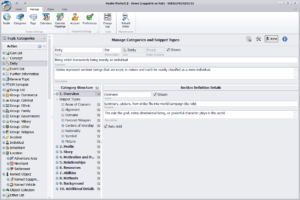 Game-specific terminology also finds its way into the category structure. In some cases, a given category’s name may vary from one game system to the next, even though it represents the same basic thing. More often, this manifests within the fields for a category, as a snippet type for the same purpose will frequently have a different name across categories.
Game-specific terminology also finds its way into the category structure. In some cases, a given category’s name may vary from one game system to the next, even though it represents the same basic thing. More often, this manifests within the fields for a category, as a snippet type for the same purpose will frequently have a different name across categories.
Let’s look at a concrete example. The generic structure provides the Entity category for handling deities and the like. Pathfinder uses the official term “Deity”, so the category is correspondingly renamed. Pathfinder also augments the Deity category with assorted new fields, including Alignment, Domains, Nationality, and Symbol (plus others).
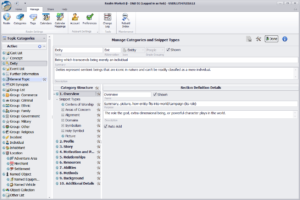 Meanwhile, D&D 5th Edition uses the same term “Deity”, so the category is again renamed. But D&D5E introduces a different, yet another overlapping set of new fields, including Alignment, Domains, Symbolism and Holy Symbol. The Alignment and Domains fields serve the identical purpose in both game systems, even though the list of valid values is distinct for each game, while the Symbol and Holy Symbol fields are two different terms for the exact same thing. And the fields are presented in a different order for each game, reflecting the sequence used within the respective rulebooks.
Meanwhile, D&D 5th Edition uses the same term “Deity”, so the category is again renamed. But D&D5E introduces a different, yet another overlapping set of new fields, including Alignment, Domains, Symbolism and Holy Symbol. The Alignment and Domains fields serve the identical purpose in both game systems, even though the list of valid values is distinct for each game, while the Symbol and Holy Symbol fields are two different terms for the exact same thing. And the fields are presented in a different order for each game, reflecting the sequence used within the respective rulebooks.
As you can see, there are numerous details to tease apart for each game system, and things can quickly get complicated, even for a single category definition that appears to be pretty simple at first glance.
Game-Specific Structure and Rules Mechanics
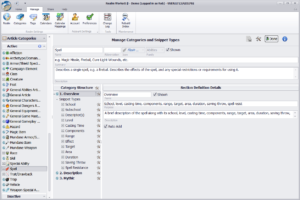 The second major aspect centers on the mechanics side. Just like within the games themselves, this is where the differences between game systems become more sharply magnified in the game-specific structure for each game. There are typically three situations that arise with mechanics.
The second major aspect centers on the mechanics side. Just like within the games themselves, this is where the differences between game systems become more sharply magnified in the game-specific structure for each game. There are typically three situations that arise with mechanics.
The simplest situation is when a completely new category is needed for the game system because no equivalent appears within the generic structure. Since the generic structure is intentionally very broadly defined, this typically only occurs a few times for each game system. When it does occur, it’s a simple matter to define the new category to appropriately reflect the game rules, as with the Spell category for Pathfinder.
The most common situation is when the game-specific changes involved are incremental for a given category. In this case, we employ the same approach as for story content, with custom snippet types being added to the generic category definition. The Mundane Item category for Pathfinder is a simple example, where a few new fields are introduced.
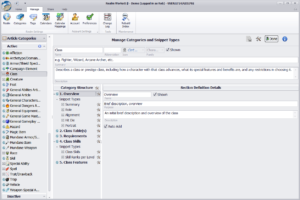 Many game systems have at least one rules component that gets decidedly more complicated, leading to the third situation. This typically arises when the game rules delineate a substantively different presentation of material from the generic structure, such as introducing entirely new sections to derived articles. When the changes are more significant, a completely new category is defined that replaces the generic one. The new category can then be given a completely different set of sections and snippet types, allowing it to accurately reflect the structure utilized within the game system rulebooks. The frequency of this situation depends entirely on the game system, how rules-heavy it is, and the extent to which the rulebooks present a formalized structure that differs from Realm Works’ generic structure. An excellent example of this is the Class category for Pathfinder.
Many game systems have at least one rules component that gets decidedly more complicated, leading to the third situation. This typically arises when the game rules delineate a substantively different presentation of material from the generic structure, such as introducing entirely new sections to derived articles. When the changes are more significant, a completely new category is defined that replaces the generic one. The new category can then be given a completely different set of sections and snippet types, allowing it to accurately reflect the structure utilized within the game system rulebooks. The frequency of this situation depends entirely on the game system, how rules-heavy it is, and the extent to which the rulebooks present a formalized structure that differs from Realm Works’ generic structure. An excellent example of this is the Class category for Pathfinder.
Tags and Their Domains
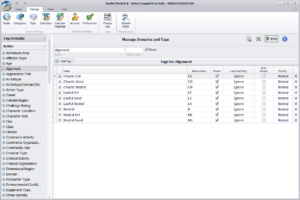 The third and final aspect of a game-specific structure centers on the set of tag domains and corresponding tags for the given RPG. Every RPG introduces a set of terminology to codify its rules and behaviors, and portions of this terminology are foundational to the content, such as races, classes, weapon types, spell schools, alignment, etc. It’s these terms that drive the various tag domains appropriate to each game system, with each domain then containing the specific list of names unique to the RPG.
The third and final aspect of a game-specific structure centers on the set of tag domains and corresponding tags for the given RPG. Every RPG introduces a set of terminology to codify its rules and behaviors, and portions of this terminology are foundational to the content, such as races, classes, weapon types, spell schools, alignment, etc. It’s these terms that drive the various tag domains appropriate to each game system, with each domain then containing the specific list of names unique to the RPG.
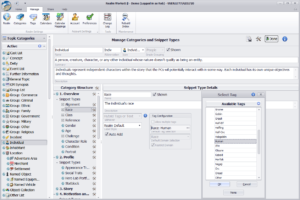 Once the set of tag domains (and tags) is defined for a game system, all of the corresponding snippet types for the game system must then be associated with the appropriate domains and tags. This ensures that each snippet type presents the correct set of options and defaults to suitable values. When designing a game-specific structure, there is no requirement whether to evolve the category structure or the tag domains first, provided the snippet types within the category are ultimately revisited to ensure they reference the correct tag domains and tags.
Once the set of tag domains (and tags) is defined for a game system, all of the corresponding snippet types for the game system must then be associated with the appropriate domains and tags. This ensures that each snippet type presents the correct set of options and defaults to suitable values. When designing a game-specific structure, there is no requirement whether to evolve the category structure or the tag domains first, provided the snippet types within the category are ultimately revisited to ensure they reference the correct tag domains and tags.
Other Wrinkles with Game-Specific Structure
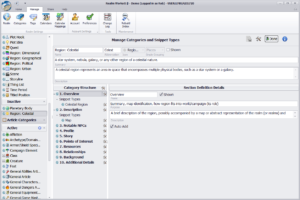 The generic structure is broad, so there will often be categories that simply don’t make sense for a particular game system. For example, the generic structure includes categories like “Planetary Body” and “Region: Celestial”, neither of which typically have any use within a medieval fantasy setting. When defining a game-specific structure, non-applicable categories are designated as inactive. As such, they won’t appear as options for selection when creating new content. However, they are merely inactive. If you wish to make use of these categories in your campaign, they can be readily made active again via the “Manage Categories” interface.
The generic structure is broad, so there will often be categories that simply don’t make sense for a particular game system. For example, the generic structure includes categories like “Planetary Body” and “Region: Celestial”, neither of which typically have any use within a medieval fantasy setting. When defining a game-specific structure, non-applicable categories are designated as inactive. As such, they won’t appear as options for selection when creating new content. However, they are merely inactive. If you wish to make use of these categories in your campaign, they can be readily made active again via the “Manage Categories” interface.
In the same way that new categories are introduced for rules mechanics that replace existing categories, replacements can similarly be introduced for categories pertaining to story content. Replacement can even be applied to tag domains. Thus far, there has not been a need for either, but it’s possible that a game system may require it in the future, so it’s worth mentioning here for completeness.
Initial Games Supported
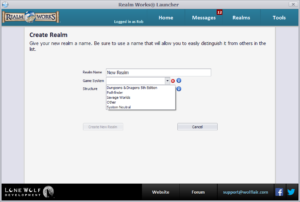 Putting together well-conceived, game-specific structures turned out to be a much more demanding process than we first envisioned. Moreover, while we believe that game-specific structures will be something users keenly want, we honestly aren’t sure. Consequently, we’re only releasing game-specific structures for a few RPGs out of the gate, consisting of Pathfinder, Dungeons & Dragons 5th Edition, and Savage Worlds. If the reaction is positive, we’ll look very seriously at introducing pre-defined structures for additional games.
Putting together well-conceived, game-specific structures turned out to be a much more demanding process than we first envisioned. Moreover, while we believe that game-specific structures will be something users keenly want, we honestly aren’t sure. Consequently, we’re only releasing game-specific structures for a few RPGs out of the gate, consisting of Pathfinder, Dungeons & Dragons 5th Edition, and Savage Worlds. If the reaction is positive, we’ll look very seriously at introducing pre-defined structures for additional games.
The export and import mechanisms within Realm Works also make it possible for users to define content structures tailored to specific game systems and share them (with a few small caveats). In the interim, this approach should serve as an excellent means of allowing users to evolve and re-use structures that are well suited to virtually any particular RPG.
The “Other” Game System
In addition to the three initial game systems, there is an “Other” option available. This structure is the generic one that is applicable to all game systems. If your campaign uses a game system other than the ones for which we’ve developed an initial structure, select “Other” for your realm. This starts you out with the entire generic structure enabled, and you can then tailor this starting structure as you wish to suit both the game system details and your own personal preferences.
What’s the Point of “System Neutral”?
At the bottom of the list of game-specific structures presented, you’ll see an option entitled “System Neutral”. This one warrants more detailed explanation since its purpose and use are very specialized. Unless you intend to share content with others that will work with virtually any game system structure, you can safely ignore the “System Neutral” structure (and the rest of this section).
So let’s take a closer look at exactly what “System Neutral” does. In a nutshell, choosing “System Neutral” strips away all categories and tag domains – and corresponding sub-elements like section and snippet types – that are game-specific in any way. Even a structure definition like “Other” has a small number of categories, snippet types, and tag domains that are unique to itself and not present for other game-specific structures. The “System Neutral” definition pares everything down to a structure that omits these aspects and leaves only a structure that should safely map to every other game system – even game-specific structures that don’t exist yet.
Why is this important? Well, if you want to create story content that can be seamlessly used within any realm, “System Neutral” is how you accomplish that. When you choose “System Neutral”, nothing game-specific can appear in the content you create, ensuring that your content has no “baggage” that will complicate import into a heavily tailored realm. By choosing “System Neutral”, you can export your material with the confidence that it should import cleanly into any realm, regardless of how its structure has been customized.
The “System Neutral” structure is utilized for some of the content that will be debuting when the Content Market launches, including both Masks and Eureka (from Engine Publishing). These products are completely generic, providing a treasure trove of fleshed out NPC personalities and plot ideas that span the entire spectrum of genres, respectively. The “System Neutral” structure ensures they’ll be usable by everyone.
The “Legacy” Game System
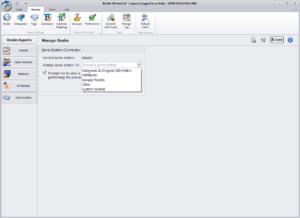 For all practical purposes, “Legacy” is basically the same as “Other”, since the differences between “Legacy” and “Other” are extremely small. However, since a few minor differences do exist, we’ve assigned “Legacy” realms a different name to make that distinction abundantly clear.
For all practical purposes, “Legacy” is basically the same as “Other”, since the differences between “Legacy” and “Other” are extremely small. However, since a few minor differences do exist, we’ve assigned “Legacy” realms a different name to make that distinction abundantly clear.
All realms created before we introduced the game-specific structures are considered to be based on the “Legacy” game system. It’s no longer possible to create a new realm based on the “Legacy” structure, nor is it possible to convert a realm to “Legacy”.
If you have a “Legacy” realm, you’ll probably be best served by converting it to one of the other options. If you play one of the RPGs for which a game-specific structure is available, you’ll likely gain a lot by converting, especially if you intend to leverage any officially shared or published content in your realm. If you play an RPG for which no such structure exists, switching to “Other” will similarly maximize your ability to utilize shared content from others, but conversion is not strictly necessary.
